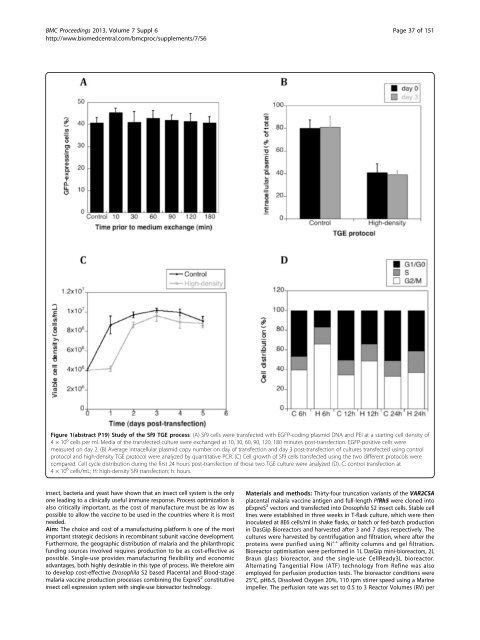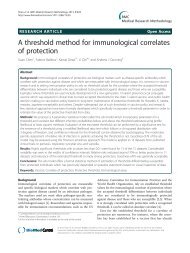Download PDF (all abstracts) - BioMed Central
Download PDF (all abstracts) - BioMed Central
Download PDF (all abstracts) - BioMed Central
Create successful ePaper yourself
Turn your PDF publications into a flip-book with our unique Google optimized e-Paper software.
BMC Proceedings 2013, Volume 7 Suppl 6<br />
http://www.biomedcentral.com/bmcproc/supplements/7/S6<br />
Page 37 of 151<br />
Figure 1(abstract P19) Study of the Sf9 TGE process. (A) Sf9 cells were transfected with EGFP-coding plasmid DNA and PEI at a starting cell density of<br />
4×10 6 cells per ml. Media of the transfected culture were exchanged at 10, 30, 60, 90, 120, 180 minutes post-transfection. EGFP-positive cells were<br />
measured on day 2. (B) Average intracellular plasmid copy number on day of transfection and day 3 post-transfection of cultures transfected using control<br />
protocol and high-density TGE protocol were analyzed by quantitative PCR. (C) Cell growth of Sf9 cells transfected using the two different protocols were<br />
compared. Cell cycle distribution during the first 24 hours post-transfection of those two TGE culture were analyzed (D). C: control transfection at<br />
4×10 6 cells/mL; H: high-density Sf9 transfection; h: hours.<br />
insect, bacteria and yeast have shown that an insect cell system is the only<br />
one leading to a clinic<strong>all</strong>y useful immune response. Process optimization is<br />
also critic<strong>all</strong>y important, as the cost of manufacture must be as low as<br />
possible to <strong>all</strong>ow the vaccine to be used in the countries where it is most<br />
needed.<br />
Aim: The choice and cost of a manufacturing platform is one of the most<br />
important strategic decisions in recombinant subunit vaccine development.<br />
Furthermore, the geographic distribution of malaria and the philanthropic<br />
funding sources involved requires production to be as cost-effective as<br />
possible. Single-use provides manufacturing flexibility and economic<br />
advantages, both highly desirable in this type of process. We therefore aim<br />
to develop cost-effective Drosophila S2basedPlacentalandBlood-stage<br />
malaria vaccine production processes combining the ExpreS 2 constitutive<br />
insect cell expression system with single-use bioreactor technology.<br />
Materials and methods: Thirty-four truncation variants of the VAR2CSA<br />
placental malaria vaccine antigen and full-length PfRh5 were cloned into<br />
pExpreS 2 vectors and transfected into Drosophila S2 insect cells. Stable cell<br />
lines were established in three weeks in T-flask culture, which were then<br />
inoculated at 8E6 cells/ml in shake flasks, or batch or fed-batch production<br />
in DasGip Bioreactors and harvested after 3 and 7 days respectively. The<br />
cultures were harvested by centrifugation and filtration, where after the<br />
proteins were purified using Ni ++ affinity columns and gel filtration.<br />
Bioreactor optimisation were performed in 1L DasGip mini-bioreactors, 2L<br />
Braun glass bioreactor, and the single-use CellReady3L bioreactor.<br />
Alternating Tangential Flow (ATF) technology from Refine was also<br />
employed for perfusion production tests. The bioreactor conditions were<br />
25°C, pH6.5, Dissolved Oxygen 20%, 110 rpm stirrer speed using a Marine<br />
impeller. The perfusion rate was set to 0.5 to 3 Reactor Volumes (RV) per

















